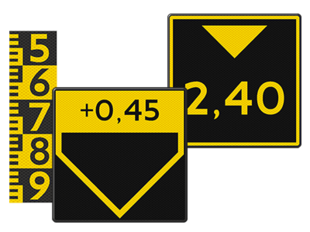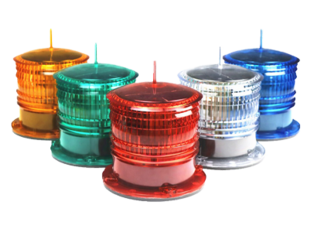Official shipping signs according guidelines for Waterway Signs and Marking
Smooth and safe navigation benefits from the application of unambiguous traffic signs, both shipping signs and signal lights, fixed and floating markings. Shipping is an international matter and the meaning of shipping signs is laid down in various international treaties, the most important being CEVNI and SIGNI. Nevertheless, there appears to be a need for further guidelines for the placement and application of shipping signs.
Waterway users, both professional and recreational vessels, must not encounter confusing situations along the waterway network. It is up to the waterway managers and contractors to apply the Shipping Sign Guidelines.
Our webshop includes shipping signs that comply with the latest Shipping Sign Guidelines
(RST 2008).
Dimensions Shipping Signs
Four standard dimensions are used to determine the size of shipping signs. The dimensions are related to the width of the water level, indicated in increasing size with types 1, 2, 3 and 4 respectively. The waterways are divided into four groups according to water level width, namely:
- water level width up to 20 meters
- water level width from 20 to 60 meters
- water level width from 60 to 170 meters
- water surface width more than 170 meters
The shipping sign types 1 to 4 correspond to the water level width groups.
Shipping sign type 0 only applies to situations in a harbor or on jetties.
| Water level width (m) | Signtype | Dimensions Square (mm) | Dimensions Rectangle (mm) | Sight distance |
| 0 | 400 x 400 mm | 400 x 600 mm | ||
| <20 meter | 1 | 600 x 600 mm | 600 x 900 mm | 120 meter |
| 20 tot 60 meter | 2 | 1000 x 1000 mm | 1000 x 1500 mm | 200 meter |
| 60 tot 170 meter | 3 | 1400 x 1400 mm | 1400 x 2100 mm | 300 meter |
| >170 meter | 4 | 2000 x 2000 mm | 2000 x 3000 mm | 400 meter |
Voor de Scheepvaartbord modellen A.1, A.10, D.1, D.2 en E.1 gelden afwijkende afmetingen
| Water level width (m) | Signtype | Dimensions Square (mm) | Dimensions Rectangle (mm) | Sight distance |
| 0 | 320 x 320 mm | 320 x 480 mm | ||
| <20 meter | 1 | 480 x 480 mm | 480 x 720 mm | 200 meter |
| 20 tot 60 meter | 2 | 800 x 800 mm | 800 x 1200 mm | 350 meter |
| 60 tot 170 meter | 3 | 1200 x 1200 mm | 1200 x 1800 mm | 550 meter |
| >170 meter | 4 | 1600 x 1600 mm | 1600 x 2400 mm | 700 meter |
Placing Shipping Signs
The signs can be divided into two groups according to their arrangement:
a. signs placed parallel to the fairway axis
b. signs perpendicular to the waterway axis
The signs referred to under a. predominantly indicate a prohibition or instruction and are placed on the side of the waterway where the prohibition or instruction applies.
Most of the characters fall under b. and generally applies to both sides of the fairway. This manner of arrangement is related to the fact that the traffic signs must be clearly visible to the waterway user during the navigation of his ship.
Installation height Shipping signs
A condition for placing traffic signs is that shipping can observe the signs properly and in good time. To achieve this, it is necessary that the signs placed on the bank are placed at a certain height. Installation height is understood to mean: the distance between the underside of the sign in question and the on-site location common average water level.
The table below shows the minimum installation height to be observed in cm in relation to the average water level. In areas where the water level can vary greatly, a practically feasible solution must be chosen. Also on waterways, where a lot of container shipping occurs, it may be desirable to choose a higher positioning height.
| Water level width (m) | Shipping Sign Square dimensions (cm) | Shipping Sign Rectangle dimensions (cm) | Minimum height (cm) |
| < 20 meter | 60 x 60 cm | 60 x 90 cm | 200 cm |
| van 20 tot 60 meter | 100 x 100 cm | 100 x 150 cm | 300 cm |
| van 60 tot 170 meter | 140 x 140 cm | 140 x 210 cm | 400 cm |
| > 170 meter | 200 x 200 cm | 200 x 300 cm | 500 cm |
Beam lighting Shipping signs
The traffic signs, the visibility of which is also essential for the safety of shipping traffic at night, must be illuminated at night. The lighting must be such that there is an even light distribution and no dazzling for shipping and road traffic occurs. The light intensity must be such that the signs are not illuminated and the symbols are clearly recognizable. During works in progress it is recommended to illuminate all traffic signs.
We supply highly energy-efficient LED beam lighting for every size of shipping sign. This lighting does not dazzle and ensures an even light distribution over the shipping signs. Because shipping signs are often placed in remote locations where there is no fixed power connection, we supply beam lighting that works completely independently on solar energy. The different versions can be found in the webshop.
Retro-reflective Shipping Signs
Application of retro-reflective material on shipping signs, which are generally not provided with lighting, for example kilometer signs, will increase the conspicuity of these signs when they are illuminated by the waterway user with a searchlight or floodlight. In order to obtain a sufficiently large reflective capacity, at least class 2 retroreflective material must be used (class 2 according to NEN 3381). As a result, the duration of searchlight use can be kept to a minimum. For certain shipping signs that must be detectable and recognizable at a great distance and/or at a large angle, a retro-reflective foil with greater wide-angleness and reflection value can be used. Retro-reflective material cannot, however, serve as a replacement for beam lighting for shipping signs, but can have a supporting role in the event of a failure of the lighting.
All our shipping signs are equipped with durable and high-quality retro-reflective foil class 2 or 3



















